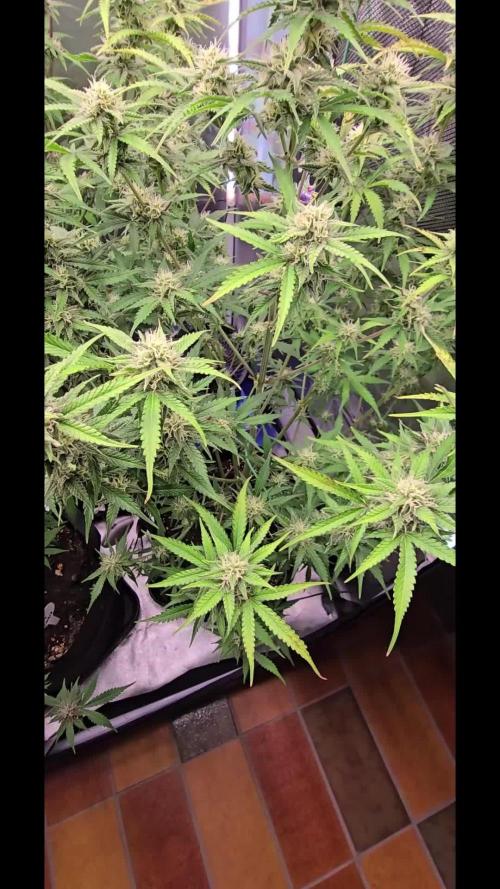The Grow Awards 2026 🏆 



































Likes
Comments
Share


@GrownwithLED
Follow
During week 12 all plants continue to get ripe and the leaves get more and more yellow fade. This is a good thing at this point, since that means the plants are FLUSHED properly and all BIO NOVA nutrients and sugars inside the plant-matter are used up. ONLY A WELL FLUSHED PLANT SMOKES SMOOTHLY WHEN DRIED!!! Since I plan to smoke these buds as my medicinal cannabis against my chronic back pain, I am extra keen on well flushed buds!
All my genetic treasures GLISTEN WITH TRICHOMES NOW! Its a beautiful sight and makes me smile every time I see them. The aroma coming from the tent is overwhelmingly strong now and makes my mouth water.
Since almost all the pistils have turned brown now, it is time to check the trichomes, if the plants are ready to harvest.
I take a hand-held microscope and carefully look at a top-bud. The trichome-heads I see, are all milky now and some of them have turned amber. Thats the perfect time to harvest, since its PEAK-THC now. When all trichome heads have turned milky the THC-content is at its highest, when they start to turn amber, THC breaks down again. The more AMBER TRICHOMES you have, the MORE SEDATIVE a plant gets and then it will make you MORE SLEEPY when you smoke it.
The SANlight EVO4-120 LEDs have done an OUTSTANDING JOB!
The quality and amount of top-grade medicinal buds I have grown under them is MUCH BETTER THAN UNDER HPS.
I can only STRONGLY RECOMMEND the SANlight LEDs...the new EVO-series works GREAT!
At the end of week 12 (=after 9 weeks of flowering) its time TO HARVEST MY GENTIC TREASURES!
Likes
4
Share


@SKUDUDUBAW
Follow
Added sticky paper to prevent pest.
Root juice + pure zym
Fed with nutrients 1/3
Likes
24
Share


@Newbiegrower420
Follow
Day one of week 7! Saturday 3rd Oct.
Yay I made it to week 7!! First week of flower!
Flipped the lights and the girls are getting their first 12 hours of darkness as I type.
As soon as it’s lights go on I’m gonna get the next lot of nutes in as they seemed almost ready for a feed when I put them to bed.
Getting a little nervous the temps are a still bit high as we go into flower but these girls seem hardy so staying positive!
UPDATE: Day 2 of week 7, Sunday 4th Oct.
Girls still looking strong and nutes gone in again today. Got a fan blowing onto the outside of my tent (which is helping lots) as the slightly lower humidity levels are really heating things up with the dehumidifier working harder inside the tent now, especially around watering time. Fan at full whack, if this doesn’t work I may have to get an intake fan but was trying to avoid extra costs. Keeping a close eye 👁️
UPDATE: Tuesday 6th October
Day 4 of week 7
Nutes in again and a little more teasing with the LST to keep the girls low on the stretch.
Think I found a little white hair 🤩🤩 (see pics).... It’s getting exciting.. 🤓
UPDATE: Thursday 8th October
Day 6 of week 7
Ok great news today.. All four ladies have some pretty little pistils all over various bud sites and no hermies in sight! Phew! 😅 Nutes going in too 👌🏼
Happy growing and all that jazz! 🍃🍁👌🏼❤️
Likes
20
Share


@ThatsmyGrow
Follow
Einfach eine super Woche
Ich bin einfach wieder komplett überzeugt davon autoflower indoor anzubauen, dank fastbuds gibt's so geile Sorten.
Ich will am ende alle mal gegrowed haben
Likes
9
Share


@Hazebuster888
Follow
In der sechsten Blütewoche haben sich die Blüten weiter verdichtet und an Größe zugenommen. Die Pflanze profitiert sichtbar von der erhöhten Lichtintensität und den zusätzlichen Netzen, die für Stabilität sorgen. Das Scrogging hat sich als äußerst effektiv erwiesen, da alle Blüten gleichmäßig Lichlt erhalten und sich prächtig entwickeln. Die Pflanze wirkt insgesamt sehr vital, und die Blütenstände zeigen eine schöne Harzbildung, was auf eine erfolgreiche Ernte hoffen lässt.
Likes
5
Share


@Major
Follow
BSB genetic is 1 week shorter than my Tropicana Banana from Barney’s Farm but it is in full bloom and has beautiful, dense leaves. beautiful quality of seeds also congratulations to all 🙏🙏🙏👏👏👏😁😁
Likes
5
Share


@GREENPHOENIX6262
Follow
*Week 5 Veg - 11/05 - 11 inches - LST bend clips used from top colas to bottom set - early flower seems to be setting in - nute feeds remain the same*
Likes
16
Share


@Foggedaboudit
Follow
These are the tallest and densest in the tent but there is little to no smell yet to them. Trichome production is very good for the stage so hopefully they develop a nose in the next couple of weeks. I’d hate to end up with rock hard frosty OG Kush buds with no smell 😀
Likes
1
Share


@DeepSouthDank
Follow
Days 9 or 10 - I think. I somehow managed to loose track despite having this journal and spreadsheet. Eish.
Its top city in this tent. Managed to get things pretty even. I will stop tucking weaving today and let the vertical growth do its thing for the rest of stretch.
Dehumidifier is in use now and inline filters.
Things start getting exciting now! 👽
Likes
33
Share


@Purrple_Haze
Follow
Stackin’ Up & Frostin’ Over ❄️🔥
Time for another Red Hot Cookies update—and things are getting thick out here! 💥
We’ve officially entered Week 3 of flowering, and the buds are swelling up beautifully. They're starting to frost over with trichomes too, which makes every morning check-in feel like unwrapping a tiny gift. 🎁✨
She’s been looking vibrant and strong, with no signs of stress despite the intense heat lately. We had several days pushing over 34°C, so I’ve been watering daily to keep her happy and hydrated. The grow routine this week looked like this:
🔸 Dosed with BioBizz Grow + Bloom + TopMax every 3 days
🔸 A round of compost tea for those living soil boosts 🌿
🔸 Effective Microorganisms to keep things biologically buzzing
⚠️ I’ve paused the silica spray now that the buds are forming
Oh—and some extra good news:
Spider mites? Gone. 🕷️🚫
They picked the wrong grow to mess with, and it feels great to see clean leaves again.
Can’t wait to see how she stacks over the next few weeks. This one’s got potential written all over it. Stay tuned! 💪🌸
Likes
17
Share


@VegHead_Lou
Follow
One week left on the 2 that are already in flower. The third just started flowering in its 7th week for some reason. This was a decent grow. I learned a lot by messing up a lot. I’m most definitely a newbie. Will be doing another run on these immediately. Have to test my skills to have it grow faster and yield more. Thank you all who has followed our journey.
Likes
13
Share


@Andres
Follow
She is growing strong and healthu but its to heavy. She is tied with a cable to the wall. She is not perfect in her leaves because she is growing outdoor and finally it is in the last stage. she grew very slow in winter with cloudy days. But now showing its potential with organic products. It is a few weeks to be cut.
Likes
39
Share


@NuttyYeti
Follow
It has been a journey but I'm happy it's over. Would have liked it to go another week or 2 but I'm happy with what I got. She smells like cotton candy and I can't wait for a taste. ☺️🤤
Likes
19
Share


@Bncgrower
Follow
The week is over, I was a little behind with the updates... the 13th was the harvest day, it was very resinous and very fragrant, now I'll wait for the drying and curing process to give my feedback in the next update.. 🌱✌️
Likes
26
Share


@Rock_n_Roll_Randy
Follow
DID SOME MORE MAJOR DEFOLIATION SO THE LIGHT CAN PENETRATE THE BOTTOM BRANCHES. NOT MANY LEAVES LEFT LOL. CHECK EM OUT NEXT WEEK TO SEE THEM HOPEFULLY EXPLODE
FINALLY STARTING THE PHOTOPERIODS AND I HOPE MY TIMING IS GOOD FOR CHOPPING THE AUTOFLOWERS..........SEEDS PUT INTO THE SOIL ON JUNE 22ND.
RUNNING OUT OF ROOM IN THE 8X8 TENT SO I PUT ALL THE PHOTOPERIODS IN THE 5X5 WITH A TSW2000. SOME FAN LEAVES ARE BIGGER THAN MY HAND NOW.
SORRY TO EVERYONE WHO TRIES TALKING TO ME....I STILL CANT TALK TO ANYONE BECAUSE I TRIED CHANGING MY EMAIL ON HERE AND IT MESSED EVERYTHING UP. I CANT LIKE ANYTHING OR COMMENT ON ANYTHING. THE WORST IS I CANT JOIN CONTESTS
STRIVE NUTRIENTS IS THE BEST IVE EVER USED. A MUST TRY AND I BUY IT MYSELF. GOT A SAMPLE LAST YEAR AND ITS SO GOOD I BOUGHT MORE. ITS A 2 PART POWDER NUTRIENT THAT DISSOLVES IN MINUTES AND YOU MIX THE SAME STRENGTH OF THE 2 PART NUTRIENTS FROM WEEK 2 UNTIL THEY ARE FINISHED (BESIDES THE FLUSH), NO MORE BULLSHIT OF SWITCHING TO BLOOM FERTILIZER. THATS MY FAVORITE THING BESIDES THE RESULTS.
CHECK EM OUT AND BELIEVE EVERYTHING YOU READ BECAUSE ITS NO BULLSHIT, AWESOME FRIENDLY AND HONEST PEOPLE
Likes
13
Share


@deFharo
Follow
🖐️👨🌾 ¡Bienvenidos amantes de la Marihuana!
Después de unas semanas de descanso de la temporada anterior, comienzo este nuevo viaje con mi bodega de marihuana llena, muchas ganas y la esperanza de conseguir la mejor cosecha de mi historia... todo por la causa!
Voy esta vez con una sativa de origen tailandés, emparentada, por origen, con otro cultivo de esta temporada: 3M ॐ Summer in Siam.
Amo las sativas y según el productor (MSNL Seeds), esta cepa es fácil de cultivar con buenos efectos estimulantes... perfecto para fumar durante todo el día!
Mi propósito las primeras semanas va a ser conseguir un buen sistema radicular y una compactación extrema con luces, después todo vendrá fácil!
En la temporada anterior conseguí mejorar mucho el sistema radicular con respecto a la anterior, pero creo que ahora puedo mejorarlo todavía más... grandes raíces dan grandes plantas!
Espero meses apasionantes cultivando mi jardín, y de esta planta espero lo mejor como con las anteriores cepas que he cultivado de MSNl Seeds... a jugar!
HASTA LA PRÓXIMA...
SALUDOS A TODOS!
================================
Info de la cepa Chocolope de MSNL seeds: https://www.marijuana-seeds.nl/chocolope-feminized-seeds
"Chocolope es la clásica Sativa con ramas largas, cogollos que se extienden a todo lo largo y delgadas hojas de color verde intenso..." MSNL seeds
- Genética: Chocolate Thai x Cannalope Haze
- 10% Indica / 90% Sativa
- Tiempo de Floración - 10-12 semanas
- Rendimiento en interior: 500 g/m²
- THC: 19%
- Sabores: Café, Castaña, Nueces
================================
Likes
10
Share


@DeepRootsGrowTrees
Follow
APRICOT GORILLA AUTO /
GANJA FARMER
Week #9 OVERALL
WEEK #3 FLOWER
This week this lady had no issues and continues to shine her buds are forming nicely and she's looking healthy 👌!! Stay Growing!!
Thank you for stopping by and taking a look it's much appreciated!!
Thank you GANJA FARMER!!
APRICOT GORILLA AUTO / GANJA FARMER
Likes
5
Share


@HighOhioAn
Follow
Loving the buds on two of the strains I’ve only had black buds one time before, and it was some of the best, but I’ve ever had super excited for this grow🔥💯





















